apricot jam
I’ve always viewed jam making to be more of an art or a science. In the US, it’s must more linear – add pectin here, or bring the jam to 222 degrees F before canning. In Russia, while everyone made his own jams and preserves, no one had pectin (never mind using it) or owned a candy thermometer. You stirred, smelled, tasted, and waited patiently, tending to the consistency of the burbling liquid. You learned from your mothers and grandmothers what couldn’t be taught in a recipe but was passed on through seasons of watching and helping out in the kitchen.
We canned a lot of our own jam back in Russia. Berries and stone fruit were only available in the summertime, and if you wanted a sweet reminder of the summer’s bounty in the cold winter months, you had to set aside a few days to make some jam. Every year, my mother and grandmothers turned out what seemed to be vats of jams, pickles, and conserves. I remember my mother skimming off the jam foam, setting it on a small plate, and then letting me eat it with some bread and butter – it was heaven.
These days I don’t do much canning at home – there is seriously limited shelf space in my kitchen, though I am contemplating freeing up some designated shoe storage space for a few jars of jam to treat ourselves through the winter months. When I make jam, it’s usually a small batch to last a few weeks – an immediate pleasure rather than a delayed one. Apricot jam, one of my two favorites (the other one being sour cherry) is something that I’ve struggled making in the past. It was either not sweet enough because I skimped on sugar; too belabored – I tried to be creative and muddled the flavor; or overcooked – it looks liquid in the pot, but when the jam comes to room temperature it’s one solid block of mushy fruit.
It was David Tanis who taught me how to make consistently perfect apricot jam every time – in his latest book, “The Heart of the Artichoke”. Not so much as a recipe, but more like a languid, meditative poem, Tanis, who now writes an inspiring weekly column for the New York Times “City Kitchen”, gently coaches to feel the jam, rather than get all scientific about it. Whenever I feel anxious or sad, I pull the book out, and open to what is, undoubtedly, the most wrinkled page in the book, and read to myself. Tanis writes, “Apricot is the ne plus ultra, the cat’s meow, of jam, and part of the thrill of making it is to take advantage of the brief apricot season.” Has a more beautiful opening sentence been written for a recipe? Don’t you want to rush back into your kitchen and rummage around for some apricots and make some jam?
There is nothing overly complicated here. You combine equal parts of apricots and sugar together, stir in some water, and heat the fruit to a simmer. Tanis tells us to stay close to the jam and stir it often, and keep an eye on the time. After 30 minutes, he says, it should start to look “right” – judging by eye is key here. When your stirring spoon stays coated with the light amber liquid, remove the jam from heat, even if it looks far too liquid to you.
The equal parts of fruit and sugar is crucial here, and until I followed Tanis’ instructions my jam always tasted a little off. Apricots, he writes, are never sweet enough for jam, and you need all that sugar to really let their flavor come through. As for the fact that there are, technically, only two ingredients to this jam – no herbs, no vanilla, no spices, no other fruit – I highly recommend that you make this jam, for the first time at least, as instructed, without trying to put your own spin on things. I know it’s tempting, especially with a recipe (if you can even call it a recipe) so simple, but sometimes it’s more about the technique than ingredients, sometimes it’s about it’s the simplest things that are most beautiful. Sometimes less is more.
More Jam on Sassy Radish: Apricot Blueberry Thyme Jam
Apricot Jam
Adapted from David Tanis’ “The Heart of the Artichoke”
Ingredients:
2 cups apricots
2 cups (400 grams) sugar
Preparation:
1. Halve the apricots, but do not peels them. Remove the pits and place the fruit and the sugar in a heavy-bottomed pot. Stir the fruit and the sugar together first to moisten the sugar. Place the pot on low heat, adding 1/2 cup water – stir. When the sugar has dissolved, turn the heat to medium and bring the mixture to a simmer. It will start to smell really good at this point. Skim off the apricot foam that will form, and set it aside. Tanis advises us to spread it on toast, or stir it into yogurt – and it’s precisely what I do.
2. Turn the heat down to low, so the jam is simmering, and stir frequently. Watch and smell the jam closely. After 30 minutes, the jam will thicken and coat the spoon. It will look, in Tanis’ terms, “right”. But it will still look too liquid to your eye. This is fine – the jam is very hot, and will thicken upon cooling.
3. Remove from heat, and let the jam cool overnight at room temperature. Should the jam look a little thin the next day, heat it on low heat, on the stove for another 15 minutes or so. If you find it a tad too thick, add a few teaspoons of water and let it summer until you get the right consistency. If the jam turns out perfectly, as has happened to me each time I have followed Tanis’ missive, ladle it into jars and refrigerate, or follow the canning instructions that come with your canning jars/kit.
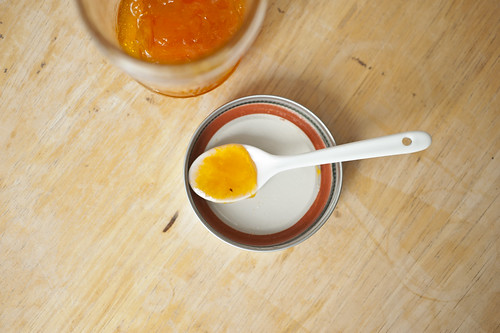
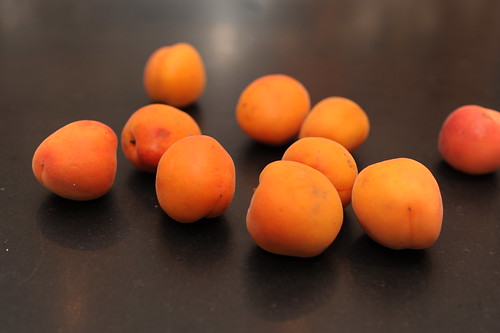
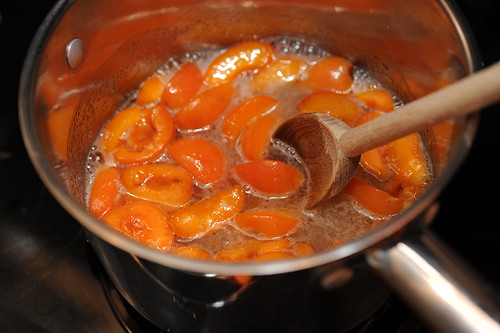
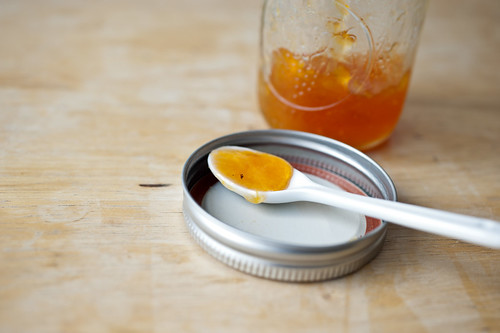
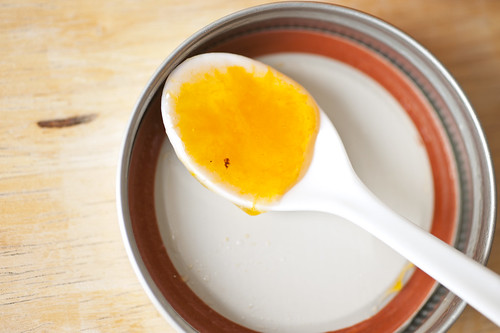
My Little Expat Kitchen
I love how you describe the process of making jam in Russia. That’s how we cook in Greece too. I learned to make jam from my grandfather who of course didn’t have any pectin around or candy thermometers.
Those who haven’t had such experiences though are oftentimes scared that they’re going to ruin a jam or preserve and feel more secure in using a thermometer. Can’t blame them.
Needless to say, your jam looks tantalizingly good :)
Magda
Lisa @ Sunny Seed Stories
As someone with a BA in English, I love the mixture of literature and cooking here!
Laura {gourmettenyc}
Jam, particularly apricot jam, instantly reminds me of summers in France. I always make at least one jam while there, and often it is apricot jam. I will definitely have to try this recipe!
Claire
Just made my own jam for the first time last week. Never going back to store-bought :) Your thoughts on jam-making being a science in the US is sadly true, I never realized how simple it was until I was standing over my own stove!
This is a wonderful, simple recipe. Will definitely be making a jar for my apricot-loving mother. Thank you!
Gretchen @ flowercityfoodie.com
I grew up watching my grandma (who lived with us) and mom make all kinds of jams, jellies, pickles, and other canned stuff without a single thermometer. They knew what to look for because they had been taught by the woman before them. I love how your story reminded me of that.
Liz @ Blog is the New Black
This looks so wonderful! I’ve never made made my own jam.
Whitney
I will have to make some of this once I’m settled in my new kitchen.
Have you made Melissa Clark’s Sour Cherry Jam with Balsamic? Oh man its really good. I blogged it here http://whitneyinchicago.wordpress.com/2011/07/13/sour-cherry-jam-with-balsamic/ but her original post is here http://www.melissaclark.net/blog/2011/06/sour-cherry-update-what-is-jam-if-not-sauce-for-toast.html
Sara
I am a huge fan of Tanis, and was also excited to see his new column. Apricot jam is a favorite of mine though I’ve never tried it (I’ve tried very few jams, in fact). And those grandmas! A highlight of our yearly trip to visit my grandparents was bringing back jars and jars of her homemade jam–raspberry being my favorite. I love apricots but am often underwhelmed by them fresh (and I’ve read that the variety that can be shipped all over is not as flavorful, and the good ones are too delicate, but alas I don’t live in California); I wonder if in a jam you don’t have that problem–if so that’s another bonus.
Ruth
It must be jam season. I helped my mum pit about 1000 cherries last night and have stained fingers to show for it. Maybe I ought to jump on the bandwagon and get jamming before summer’s bounty dries up!!
Jessica
Oh, I wish I had this recipe last year! A woman in my neighborhood has two apricot trees that were completely loaded with tiny apricots. I made a huge pot of jam for the first time ever! Sadly, this year the frost got to the blooms and there are no apricots. But there is always next year :)
Radish
Whitney – I haven’t made it, but Melissa let me sample some and I was in heaven. It truly is extraordinary and exactly the accent sour cherries needed. It was genius on Melissa’s part.
Sanjeeta kk
Love the vibrant orange color of the preserve! Beautiful clicks.
Katie@Cozydelicious
I love the image of you as a little kid eating toast with jam foam! I ador emaking jam, and apricot is a major hit in my house.
Carla
Thank you for inspiring me to make apricot jam. I hate store bought, but the homemade version tastes divine!
Carly
I took this overcast morning as a sign to make this jam before the heat returned &I wouldnt want to return to the kitchen stove– it came out great. There was a moment at the 30 minute mark where I wasn’t sure it was right, so I walked away for another 7 minutes, and I was right to do so– when i returned, the smell, and appearance had morphed in to what I imagined the jam to look like. It is currently setting up perfectly. Thanks for sharing the recipe. I love recipes where it’s more of a story of how to make ___ rather than a hard and fast set of rules.
Kathryn @ Dramatic Pancake
Olga, this looks delicious, and apricot is one of my favorites! I love your approach to making it as well — feeling it out rather than just following some instructions to the T. I also love how you weave in the story that goes behind the food.
Anita
You just made me cry with the jam foam sentence – my mom did that too, and I’d forgotten all about it!
Preserving Summer | Cook Books & Ceilithe
[…] Apricot – From a fun blog called Sassy Radish, this recipe took no time at all. I doubled it, but you could easily make a quick batch to use immediately and skip the canning process. Look how beautiful it was as it cooked down. https://www.olgamassov.com/2011/07/apricot-jam/#more-2004 […]
Agnes
Beautiful post! I do like when you tell about your childhood in Russia. Ever tried making mirabelle plum jam? (the yellow kind)..it tastes of both plums and apricots and is divine – possibly my favourite jam of all times. In Denmark, where I live, the mirabelle trees grow wild – I thought they might do so in Russia as well…
jennifer
waw. thanks for the peparation method. i’d like to try.
Cobus
Here in SA it is now apricot time and i cook it the same without the water
Midnight Pasta With Garlic, Anchovy, Capers and Red Pepper | Sassy Radish
[…] gem of a recipe comes from the one and only David Tanis. He of the apricot jam fame. He of the tripe in tomato sauce fame (something I will most certainly make this winter). And […]
peach jam with apricots and black pepper | Sassy Radish
[…] bruised peaches, I decided to put up a few jars of jam. I’ve written before about my love of both apricot and peach jams. Every year, I make a few jars and hope they last me through the winter, but instead […]
Estelle
Love reading this recipe. Am a little perplexed about waiting for jam to cool after cooking. If I feel that my jam has reached the point of setting, I check with a cold dish in the freezer for jam to crinkle up, then I ladle into sterile jars. Are you suggesting that I wait to ladle into sterile jars until the next day?
Hmmmm, need an explanation.
Thank you
olga
Estelle – yes, when I follow David Tanis’ instructions, I leave it, covered, overnight (I usually make jam at night). And then can it appropriately. Most often I make such small batches, that canning instructions aren’t necessary, however, if you do want to can, follow your regular canning process and then ladle the jam, room temperature, into the jars. Hope this helps!
Estelle
Thank you Olga. I presume then I would have to heat up the jam to put into steril jars. I don’t use a canner but use hot sterile jars and I place the hot jam into the jars and cover with sterile lids. They seal that way.
olga
Estelle – exactly, the usual canning business :)
Jordan
D. Tanis’s apricot jam is a wonderful starting point for a recipe.
In case it might be useful, here are particulars of apricot jam made today (June 2014), very well.
Purchased 13# of apricots at the farmers market near me in San Francisco. Paid $20. They were $2/pound but a discount for ten pounds got me … 13 pounds.
I picked specially small apricots, most of them about 50cent coin size. Really pretty small, number of them with some green skin, and many perfectly golden ripe.
After pitting them all and tossing some, saving five or so for my table display, I had eleven plus a little bit pounds of pitted ‘cots. Used 9 pounds of white sugar, five large lemons juiced, two tablespoons of tapioca ground fine, and a large splash of triple sec. Plus a cup and a half of cold water.
Cooked them all in a very heavy bottom pot, after 20 minutes the sugar started to melt and the whole thing started to become liquid.
It took about a half hour (due to large volume) before the apricots started to bubble and foam, stirring very frequently. Then I turned it down and stirred less frequently. For 30 minutes simmered the pot, then felt it needed more time and simmered for another 15 minutes.
In my stirring at the end I used a large spoon to mush the apricots against the side of pot, this helped make the jam become more evenly liquid. At the end and after letting things cool for a half hour I got 15 qt jars of the most delicious jam you could imagine. Really lovely jam, my frig is full.
Between slicing the fruit, and everything, it took three hours start to finish. But note … this was for a very large qty.
olga
Jordan – thanks so much. Though a question: why tapioca? I’ve never heard of jam made with it.
Cara
Thank you for this simple recipe! And a super duper thank you for including the tip of putting the foam on toast. I would have never thought to use it! Plus it gives me a sample of the final product!
Greta
Finally the week I have been waiting for all summer! Beautiful, tiny apricots .99 cents a pound! Got enough to make 2 cups (about 1 pound) and jam is simmering away as I type! Smells so scrumptious, cannot wait to try it! I would have bought more apricots, but wanted to make a small batch only without canning